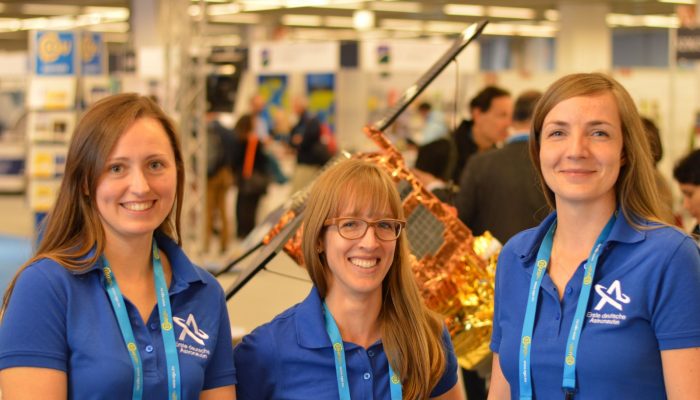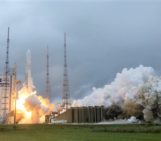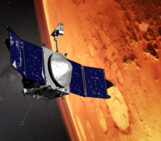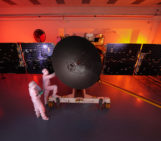
Space science has always been an exciting relative of the geosciences, and so it may come as no surprise that the woman who could become Germany’s first female astronaut attended the EGU General Assembly this year. Insa Thiele-Eich has made it to the final of Germany’s ‘Die Astronautin’ competition, which intends to send a German female astronaut to the International Space Station for a ten day research mission in 2020. She’s also a meteorologist and is currently finishing up a PhD on flooding in Bangladesh.
Insa wasn’t the only Die Astronautin competitor exhibiting at EGU and was joined by several female geoscientists who took part in the contest. Liv Heinecke and Sandra Tippenhauer also made it into the final rounds of the tough competition while juggling careers as geoscientists. Liv is coming to the end of her PhD on lake sediments in the Pamir Mountains in Tajikistan, while Sandra researches physical oceanography and the effect on ocean biology.
We caught up with them at the EGU booth to find out about why they applied to be an astronaut and how their experiences of geoscience influenced their decision.
What made you apply to Die Astronautin?
Insa: It’s been a dream for me, as I think for all of us, we’ve been wanting to do this for so long that I don’t think anybody was surprised that any of us applied- for my family is was more like ‘oh ok- you finally had the opportunity’
Liv: The call was for scientists and engineers- STEM women- and I thought ‘yep, that sounds pretty cool!’ They asked for outdoor experience and usually in our field we go into the field- to Siberia, Antarctica- something like that. So you need to be adventurous, excitable and you need to love your work. It is also encouraging girls to go into STEM. I have two kids and I don’t ever want anyone to tell my daughter she can’t get a Nobel Prize in physics.
Sandra: I always wanted to be an astronaut since, I don’t know when! It made me think want I would do [to be an astronaut] so I decided to go into science. I really love my job in science; I always want to know how things work so studying physics was the right decision. I also work with the earth to try and understand how things work- at the moment I apply it to the oceans. I love the ocean and I live really close to it so I can go out and immediately see what I’m working with! But I also love space and I’d love to do science in space.
What was the application process like?
Insa: Initially there were 409 applicants, which were reduced to 120 and asked to fill out a medical questionnaire. Then 90 were invited to go to Hamburg for the first stage of cognitive testing, so that was maths, physics, memory span and a lot of other cognitive tests. And from those 90 we were reduced to 30, who continued on.
Then it was five days in groups of six. That was more group psychological testing and a psychological interview about yourself and how you work in a team as teamwork is essential. I think that’s where being a geoscientists, always having to go out and do fieldwork, really helps. You’re usually in a stressful situation because you (usually) have little funding, or you have to perform now because you can’t do it again. You have to cooperate; you’re often jetlagged with little sleep! So it really helps!
Also working in an international field, for me at least, has helped. You know- stay calm, assess, does everyone know what we’re talking about here? As everyone’s from different background, especially when you do interdisciplinary work you have to be a very good team player.
I just wanted to add that there are so many geoscientists that applied that we actually agreed to meet at EGU. I know at least of eight in addition to myself, but it’s probably even more- so I thought that was pretty amazing.
Interview by Keri McNamara, Video by Kai Boggild, EGU 2017 press assistants.



